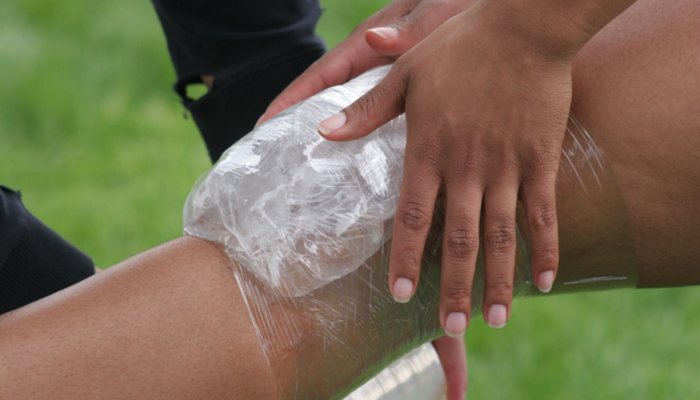Maintain a Healthy Weight
[wavebreakmedia](http://www.shutterstock.com/pic-119371003/stock-photo-three-women-doing-sit-ups-on-exercise-balls-in-gym.html)Obesity causes significant knee pain for many people. When an individual is only moderately overweight, the extra weight increases stress on joints. In fact, Johns Hopkins Arthritis Center explains, “Being only 10 pounds overweight increases the force on the knee by 30-60 pounds with each step.” An overweight individual is more at risk for arthritis of the knee and other problems such as injuries. There is extensive documented research that proves a correlation between obesity and an increased risk of developing osteoarthritis of the knee.Losing weight or maintaining your current healthy weight helps to avoid knee pain and lessens your risk of developing conditions such as arthritis of the knee.
Warm Up
[dirima](http://www.shutterstock.com/pic-377516335/stock-photo-women-stretching-for-warming-up-before-running-or-working-out-fitness-and-healthy-lifestyle-concept.html)Warming up before exercising helps lessen the stress on your knees. Warming up includes stretching your muscles to reduce the stress on tendons as well as the pressure on your knees. Some people choose other types of low-impact activity to warm up such as walking.It is also important that you engage in stretching again after exercising to avoid knee pain.
Stop Exercising If You Experience Pain
[brocreative](http://www.shutterstock.com/pic-245395468/stock-photo-female-runner-listening-to-music-while-getting-ready-for-a-run.html) Some people seem to believe that if exercise does not cause pain, you do not get the healthy benefits of exercising. However, quite the opposite is true.Exercise should not be painful in order for you to reap the rewards of exercising. If you experience actual pain while exercising, the Arthritis Foundation advises “Stop and cool down.”
Wear Properly Fitting Shoes
[ekapong](http://www.shutterstock.com/pic-93871717/stock-photo-tying-sports-shoe.html?)It is crucial to wear properly fitting shoes to lessen your risk of developing or worsening knee pain. While shoes that do not fit properly often contribute to foot problems, shoes that fit poorly also contribute to knee pain. Everyday Health points out that properly fitting shoes helps maintain proper balance and leg alignment, which in turn helps prevent knee injuries.When shopping for properly fitting shoes, do not buy a pair of shoes based solely on what size shoe you believe you wear. Properly fitting shoes vary from one manufacturer to the next, one style to the next and other factors. Always try on each pair of shoes and walk in them before purchasing them.
Eat a Healthy Diet
[racorn](http://www.shutterstock.com/pic-274546628/stock-photo-happy-healthy-young-woman-wearing-glasses-pouring-vegetable-smoothies-freshly-made-from-assorted-vegetable-ingredients-on-her-kitchen-counter.html)Inflammation contributes to issues that affect knee health. Eating a healthy diet that includes colorful fruits and vegetables and foods rich in omega-3s helps fight inflammation.Avoiding unhealthy foods such as salty, fried foods and refined carbs helps lower your risk of inflammation, which potentially contributes to health issues affecting the knees such as lupus or some types of arthritis.
Do Not Suddenly Change the Intensity of Your Run or Workout
[lzf](http://www.shutterstock.com/pic-255001651/stock-photo-healthy-lifestyle-sports-woman-running-on-wooden-boardwalk-sunrise-seaside.html)While it is admirable that you want to get a good workout, do not suddenly change the intensity of your run or other type of exercise. When you suddenly change intensity while running or performing another type of exercise, you risk suffering an injury to your knees. Instead, build up intensity gradually when running or working out to lessen your chances of developing a painful knee injury.Avoid Sudden Movements During Exercise or Sports
[jacob\_lund](http://www.shutterstock.com/pic-364241330/stock-photo-close-up-of-an-athletes-feet-wearing-sports-shoes-on-a-challenging-dirt-track-trail-running-workout-on-rocky-terrain-outdoors.html)The anterior cruciate ligament (ACL), located at the front of the knee is a common site for knee injuries. Another part of the knee that is a frequent site for knee injuries is the medial collateral ligament (MCL). When an individual sustains injury to these areas of the knee, the common cause of the injury is often due to sudden movements.HealthDay explains common knee injuries, saying, “Many ACL tears are caused by quickly changing direction, twisting, slowing down when running, or landing from a jump.” HealthDay says that football players often sustain MCL injuries, pointing out, “A simple misstep or twist can tear knee cartilage.”
In addition to avoiding sudden movements, you can also lessen your risk for knee pain and injury by wearing proper protective sports equipment.
Build Strength When Involved in Exercise or Sports Activity
[antoniodiaz](http://www.shutterstock.com/pic-167044349/stock-photo-beautiful-latin-woman-doing-push-ups-in-the-gym-before-lifting-some-weights.html?)The Harvard University *Harvard Health Letter* discusses the benefits of physical therapy. Stressing the importance of stretching to keep muscles flexible, Harvard says, “The main component of joint surgery avoidance is strengthening the muscles that support your joints.”Gradually developing strength through physical therapy helps assure setting the proper pace for building strength. Harvard quotes David Nolan, a physical therapist at Massachusetts General Hospital, who says, “The stronger your quads are, the less load that gets transferred into the joint.”
Avoid Increased Pain If You Have Arthritis
[syda\_productions](http://www.shutterstock.com/pic-241816303/stock-photo-healt-dieting-home-and-happiness-concept-smiling-sporty-teenage-girl-with-green-salad-at-home.html) People with arthritis or other painful autoimmune disorders often hear of an “Arthritis diet” or an “Anti-inflammatory diet.” While there is no specific diet plan specifically geared towards preventing or curing inflammation, there are specific foods that can help reduce inflammation and others that potentially increase inflammation. Inflammation often affects the knees, causing knee pain.Eat foods such as dark leafy greens, red or orange peppers, citrus foods or fish such as mackerel or salmon. Avoiding foods such as fatty or salty foods, corn oil, alcohol and soda can help reduce your risk of inflammation, which can help you avoid knee pain.
If you have arthritis and experience knee pain, remember that moving helps decrease the knee pain. However, check with your primary care doctor or rheumatologist before engaging in any exercise program.
RICE
[ralph\_r\_echtinaw](http://www.shutterstock.com/pic-1238888/stock-photo-ice-on-a-knee.html)RICE stands for Rest, Ice, Compression, Elevate.Rest after strenuous activity. However, do not avoid using your knees for too long to avoid stiffness.
Ice for no more than 20 minutes at a time after a workout, run or strenuous activity to help avoid knee pain.
Compression bandages reduce swelling, which often causes pain. Talk to a healthcare provider to determine the proper type of compression for your needs.
Elevate your legs to help control and reduce swelling and pain in your knees.
